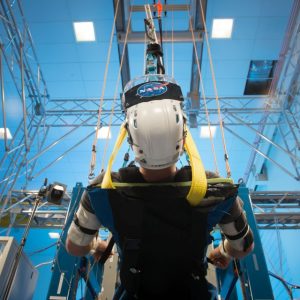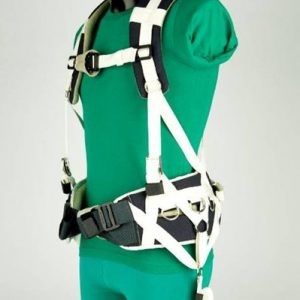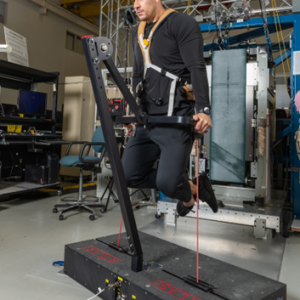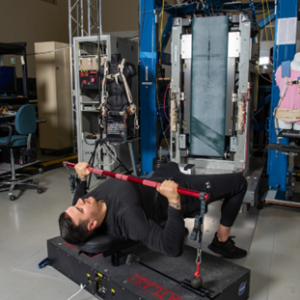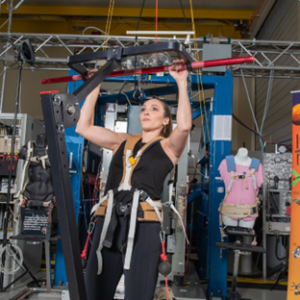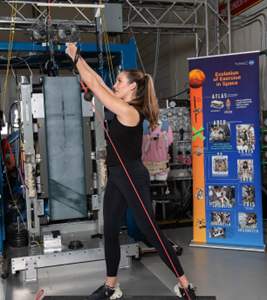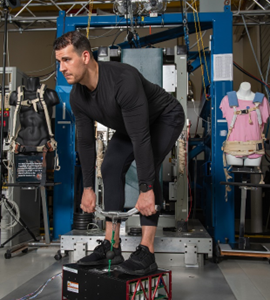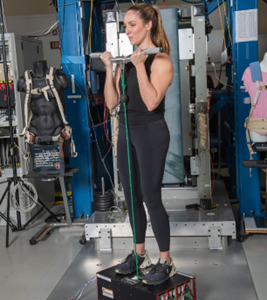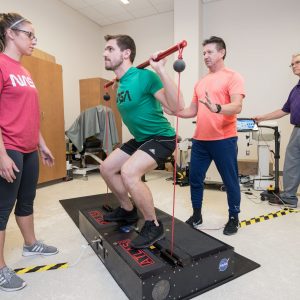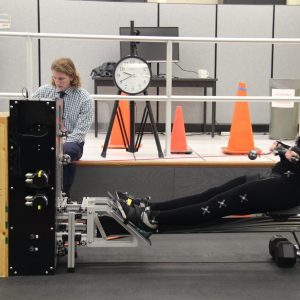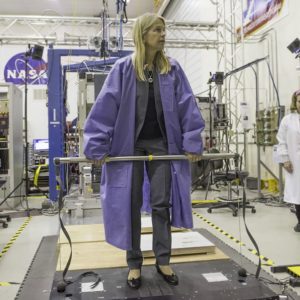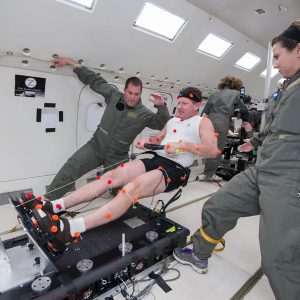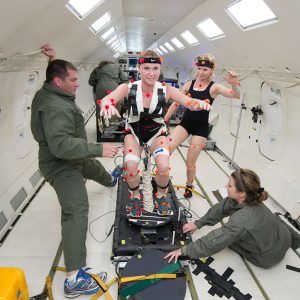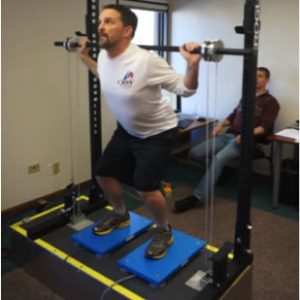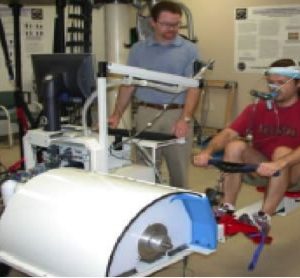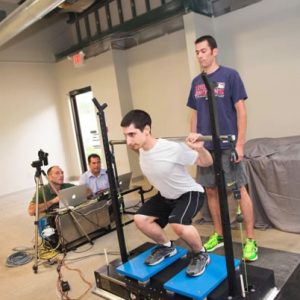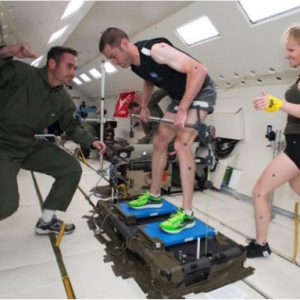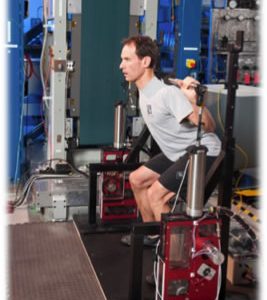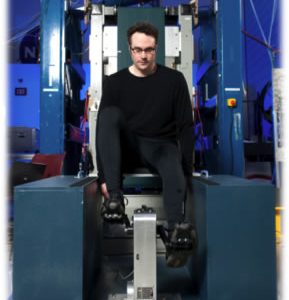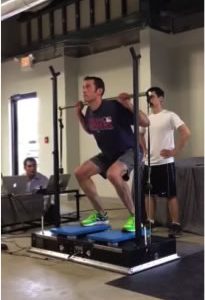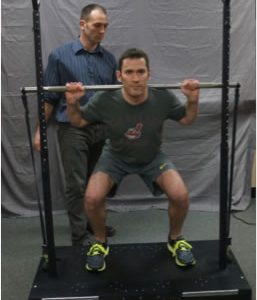Advanced Exercise Concepts
The Challenge
Given that skeletal muscles undergo reduced mass, strength and endurance in flight, there is a possibility the crew will be physically unable to perform mission tasks. There will be vehicle’s configuration constraints for long duration exploration missions including size, mass, and power capacity for an exercise system.
The Research
Glenn Research Center has developed the functional requirements needed for the exercise countermeasure system to be used during long duration exploration missions based on stakeholder feedback from the NASA exercise physiology, astronaut strength conditioning and rehabilitation, crew office, countermeasures systems and flight surgeon groups, and referencing the NASA-STD-3001 Standard for bone, muscle and aerobic capacity. The exercise hardware must protect crew fitness and fit in a much smaller footprint than current exercise hardware on the International Space Station. A trade study was conducted of NASA and industry technologies that would be suitable for such an application, and a handful of concepts were identified as having potential to meet requirements.
The Progress
New prototype exercise device concepts are under development and are being tested to provide aerobic and resistive exercise training for 30 continuous minutes each day by each crewmember for missions greater than 8 days. In addition to testing on parabolic flights, exercise device concepts are included in ground-based analog environments that simulate long duration missions in a closed facility.
These concepts are being developed by NASA and its industry partners based on the results of the trade study and the constraints of the vehicle. Each exercise device will be tested and verified against an equivalent set of criteria, undergoing a series of quantitative and qualitative evaluations with humans in the loop, and the top performing device and device features will be selected for further development and delivery for integration into the next generation of exploration missions.
The most promising advanced exercise device concepts in terms of capabilities and maturity are the Advanced Twin Lifting and Aerobic System (ATLAS) and resistive overload combined with kinetic yoyo (ROCKY) devices. NASA partnered with ZIN Technologies, Inc. of Middleburg Heights, Ohio on the development and testing of these two devices.
Acronyms
ATLAS – Advanced Twin Lifting and Aerobic System
HERO – High Eccentric Resistive Overload
HULK – Hybrid Ultimate Lifting Kit
M-MED – Multi-Mode Exercise Device
NGRED – Next Generation Resistive Exercise Device
ROCKY – resistive overload combined with kinetic yoyo
Advanced Exercise Concepts Gaps
M7 Efficient Exercise Regimen
M9 Exercise Hardware
Videos
The Hybrid Ultimate Lifting Kit (HULK) was tested in parabolic flight at Johnson Space Center. Several new configurations of the device were tested in a 30 second interval of zero-g for efficacy in a balance challenge exercise, the narrow-grip dead lift, and the single point harness squat. HULK is the predecessor to the ATLAS exercise device, which has additional capabilities, lower mass, higher fidelity to the gold standard of free weights, and added safety features.
Gallery
Cardiovascular Impacts
What are the in-flight alterations in cardiac structure and function?
Evidence from medical records, spaceflight operations and research findings provides the basis for identifying the most significant human risks in space exploration, including physiological and performance effects from hazards such as altered gravity, radiation, hostile/closed environments, isolation and distance. Each risk is assigned to an HRP Element (divisions of human research) to identify knowledge gaps, or the critical questions that must be answered, in order to mitigate the risk. These gaps become the focus of research conducted to reduce the likelihood and consequence of risks becoming a reality. To learn more about the Risk Identification and Mitigation process and the tasks developed to reduce those risks for the program please click on the link below the gap for more information.
Measuring VO2 inflight
What is VO2max in-flight and immediately post-flight?
Evidence from medical records, spaceflight operations and research findings provides the basis for identifying the most significant human risks in space exploration, including physiological and performance effects from hazards such as altered gravity, radiation, hostile/closed environments, isolation and distance. Each risk is assigned to an HRP Element (divisions of human research) to identify knowledge gaps, or the critical questions that must be answered, in order to mitigate the risk. These gaps become the focus of research conducted to reduce the likelihood and consequence of risks becoming a reality. To learn more about the Risk Identification and Mitigation process and the tasks developed to reduce those risks for the program please click on the link below the gap for more information.
Predicting Heart Disease
Can manifestations of sub-clinical or environmentally induced cardiovascular diseases during spaceflight be predicted?
Evidence from medical records, spaceflight operations and research findings provides the basis for identifying the most significant human risks in space exploration, including physiological and performance effects from hazards such as altered gravity, radiation, hostile/closed environments, isolation and distance. Each risk is assigned to an HRP Element (divisions of human research) to identify knowledge gaps, or the critical questions that must be answered, in order to mitigate the risk. These gaps become the focus of research conducted to reduce the likelihood and consequence of risks becoming a reality. To learn more about the Risk Identification and Mitigation process and the tasks developed to reduce those risks for the program please click on the link below the gap for more information.
Outcome of Medical Events
We do not know the quantified health and mission outcomes due to medical events during exploration missions.
Evidence from medical records, spaceflight operations and research findings provides the basis for identifying the most significant human risks in space exploration, including physiological and performance effects from hazards such as altered gravity, radiation, hostile/closed environments, isolation and distance. Each risk is assigned to an HRP Element (divisions of human research) to identify knowledge gaps, or the critical questions that must be answered, in order to mitigate the risk. These gaps become the focus of research conducted to reduce the likelihood and consequence of risks becoming a reality. To learn more about the Risk Identification and Mitigation process and the tasks developed to reduce those risks for the program please click on the link below the gap for more information.
Doctor on Board?
We do not know how the inclusion of a physician crew medical officer quantitatively impacts medical risk during exploration missions.
Evidence from medical records, spaceflight operations and research findings provides the basis for identifying the most significant human risks in space exploration, including physiological and performance effects from hazards such as altered gravity, radiation, hostile/closed environments, isolation and distance. Each risk is assigned to an HRP Element (divisions of human research) to identify knowledge gaps, or the critical questions that must be answered, in order to mitigate the risk. These gaps become the focus of research conducted to reduce the likelihood and consequence of risks becoming a reality. To learn more about the Risk Identification and Mitigation process and the tasks developed to reduce those risks for the program please click on the link below the gap for more information.
Microgravity Countermeasures
How does 1/6-g and 3/8-g influence countermeasures?
Evidence from medical records, spaceflight operations and research findings provides the basis for identifying the most significant human risks in space exploration, including physiological and performance effects from hazards such as altered gravity, radiation, hostile/closed environments, isolation and distance. Each risk is assigned to an HRP Element (divisions of human research) to identify knowledge gaps, or the critical questions that must be answered, in order to mitigate the risk. These gaps become the focus of research conducted to reduce the likelihood and consequence of risks becoming a reality. To learn more about the Risk Identification and Mitigation process and the tasks developed to reduce those risks for the program please click on the link below the gap for more information.
Efficient Exercise Regimen
Develop the most efficient and effective exercise program for the maintenance of muscle function.
Evidence from medical records, spaceflight operations and research findings provides the basis for identifying the most significant human risks in space exploration, including physiological and performance effects from hazards such as altered gravity, radiation, hostile/closed environments, isolation and distance. Each risk is assigned to an HRP Element (divisions of human research) to identify knowledge gaps, or the critical questions that must be answered, in order to mitigate the risk. These gaps become the focus of research conducted to reduce the likelihood and consequence of risks becoming a reality. To learn more about the Risk Identification and Mitigation process and the tasks developed to reduce those risks for the program please click on the link below the gap for more information.
Minimum Exercise Needed?
What is the minimum exercise regimen needed to maintain fitness levels for tasks?
Evidence from medical records, spaceflight operations and research findings provides the basis for identifying the most significant human risks in space exploration, including physiological and performance effects from hazards such as altered gravity, radiation, hostile/closed environments, isolation and distance. Each risk is assigned to an HRP Element (divisions of human research) to identify knowledge gaps, or the critical questions that must be answered, in order to mitigate the risk. These gaps become the focus of research conducted to reduce the likelihood and consequence of risks becoming a reality. To learn more about the Risk Identification and Mitigation process and the tasks developed to reduce those risks for the program please click on the link below the gap for more information.
Exercise Hardware
Identify and validate exploration countermeasure hardware for the maintenance of muscle function.
Evidence from medical records, spaceflight operations and research findings provides the basis for identifying the most significant human risks in space exploration, including physiological and performance effects from hazards such as altered gravity, radiation, hostile/closed environments, isolation and distance. Each risk is assigned to an HRP Element (divisions of human research) to identify knowledge gaps, or the critical questions that must be answered, in order to mitigate the risk. These gaps become the focus of research conducted to reduce the likelihood and consequence of risks becoming a reality. To learn more about the Risk Identification and Mitigation process and the tasks developed to reduce those risks for the program please click on the link below the gap for more information.
Time Course of Changes in Muscle
Characterize the time course of changes in muscle protein turnover, muscle mass, and function during long duration space flight.
Evidence from medical records, spaceflight operations and research findings provides the basis for identifying the most significant human risks in space exploration, including physiological and performance effects from hazards such as altered gravity, radiation, hostile/closed environments, isolation and distance. Each risk is assigned to an HRP Element (divisions of human research) to identify knowledge gaps, or the critical questions that must be answered, in order to mitigate the risk. These gaps become the focus of research conducted to reduce the likelihood and consequence of risks becoming a reality. To learn more about the Risk Identification and Mitigation process and the tasks developed to reduce those risks for the program please click on the link below the gap for more information.
Bone Health Standard
A new acceptable bone health standard using an expanded surrogate for bone health needs to be defined for the flight environment.
Evidence from medical records, spaceflight operations and research findings provides the basis for identifying the most significant human risks in space exploration, including physiological and performance effects from hazards such as altered gravity, radiation, hostile/closed environments, isolation and distance. Each risk is assigned to an HRP Element (divisions of human research) to identify knowledge gaps, or the critical questions that must be answered, in order to mitigate the risk. These gaps become the focus of research conducted to reduce the likelihood and consequence of risks becoming a reality. To learn more about the Risk Identification and Mitigation process and the tasks developed to reduce those risks for the program please click on the link below the gap for more information.
Osteoporosis & Fractures
What is the incidence & prevalence of early onset osteoporosis or fragility fractures due to exposure to spaceflight.
Evidence from medical records, spaceflight operations and research findings provides the basis for identifying the most significant human risks in space exploration, including physiological and performance effects from hazards such as altered gravity, radiation, hostile/closed environments, isolation and distance. Each risk is assigned to an HRP Element (divisions of human research) to identify knowledge gaps, or the critical questions that must be answered, in order to mitigate the risk. These gaps become the focus of research conducted to reduce the likelihood and consequence of risks becoming a reality. To learn more about the Risk Identification and Mitigation process and the tasks developed to reduce those risks for the program please click on the link below the gap for more information.
Ocular changes
We do not know the etiological mechanisms and contributing risk factors for ocular structural and functional changes seen in-flight and post-flight.
Evidence from medical records, spaceflight operations and research findings provides the basis for identifying the most significant human risks in space exploration, including physiological and performance effects from hazards such as altered gravity, radiation, hostile/closed environments, isolation and distance. Each risk is assigned to an HRP Element (divisions of human research) to identify knowledge gaps, or the critical questions that must be answered, in order to mitigate the risk. These gaps become the focus of research conducted to reduce the likelihood and consequence of risks becoming a reality. To learn more about the Risk Identification and Mitigation process and the tasks developed to reduce those risks for the program please click on the link below the gap for more information.
Medical Event Risk Metrics
We need to characterize the medical conditions that can occur during exploration missions and their relevant associated end states, management options, and the capabilities necessary to manage them (what can happen, how bad could it be, what can we do to improve it?).
Evidence from medical records, spaceflight operations and research findings provides the basis for identifying the most significant human risks in space exploration, including physiological and performance effects from hazards such as altered gravity, radiation, hostile/closed environments, isolation and distance. Each risk is assigned to an HRP Element (divisions of human research) to identify knowledge gaps, or the critical questions that must be answered, in order to mitigate the risk. These gaps become the focus of research conducted to reduce the likelihood and consequence of risks becoming a reality. To learn more about the Risk Identification and Mitigation process and the tasks developed to reduce those risks for the program please click on the link below the gap for more information.
Integrated Exploration Medical System Models
We need to develop integrated exploration medical system models for the Moon and Mars.
Evidence from medical records, spaceflight operations and research findings provides the basis for identifying the most significant human risks in space exploration, including physiological and performance effects from hazards such as altered gravity, radiation, hostile/closed environments, isolation and distance. Each risk is assigned to an HRP Element (divisions of human research) to identify knowledge gaps, or the critical questions that must be answered, in order to mitigate the risk. These gaps become the focus of research conducted to reduce the likelihood and consequence of risks becoming a reality. To learn more about the Risk Identification and Mitigation process and the tasks developed to reduce those risks for the program please click on the link below the gap for more information.
Cardiovascular Impacts from Weightlessness
Determine whether long-duration weightlessness induces cardiovascular structural and functional changes and/or oxidative stress & damage (OSaD)/inflammation, that can contribute to development of disease.
Evidence from medical records, spaceflight operations and research findings provides the basis for identifying the most significant human risks in space exploration, including physiological and performance effects from hazards such as altered gravity, radiation, hostile/closed environments, isolation and distance. Each risk is assigned to an HRP Element (divisions of human research) to identify knowledge gaps, or the critical questions that must be answered, in order to mitigate the risk. These gaps become the focus of research conducted to reduce the likelihood and consequence of risks becoming a reality. To learn more about the Risk Identification and Mitigation process and the tasks developed to reduce those risks for the program please click on the link below the gap for more information.
Fluid Intake
Is it necessary to increase crew fluid intake and, if possible, to what extent will it mitigate stone formation?
Evidence from medical records, spaceflight operations and research findings provides the basis for identifying the most significant human risks in space exploration, including physiological and performance effects from hazards such as altered gravity, radiation, hostile/closed environments, isolation and distance. Each risk is assigned to an HRP Element (divisions of human research) to identify knowledge gaps, or the critical questions that must be answered, in order to mitigate the risk. These gaps become the focus of research conducted to reduce the likelihood and consequence of risks becoming a reality. To learn more about the Risk Identification and Mitigation process and the tasks developed to reduce those risks for the program please click on the link below the gap for more information.
Frequency of formation
What is the frequency of post-flight stone formation; the incidence and types of stones; and the time course of stone formation? How does stone formation correlate with food intake and hydration status?
Evidence from medical records, spaceflight operations and research findings provides the basis for identifying the most significant human risks in space exploration, including physiological and performance effects from hazards such as altered gravity, radiation, hostile/closed environments, isolation and distance. Each risk is assigned to an HRP Element (divisions of human research) to identify knowledge gaps, or the critical questions that must be answered, in order to mitigate the risk. These gaps become the focus of research conducted to reduce the likelihood and consequence of risks becoming a reality. To learn more about the Risk Identification and Mitigation process and the tasks developed to reduce those risks for the program please click on the link below the gap for more information.

